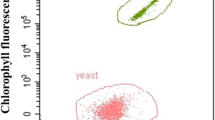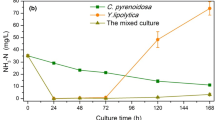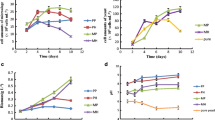Abstract
The symbiosis potential of microalgae and yeast is inherited with distinct advantages, providing an economical venue for their scale-up application. To assess the advantage of the mixed culture of microalgae Chlorella vulgaris and yeast Yarrowia lipolytica for treatment of liquid digestate of yeast industry (YILD) and cogeneration of biofuel feedstock, the cell growth characteristic, the nutrient removal efficiency, the energy storage potential of the mono, and mixed culture were investigated. The results indicated that the biomass concentration of the mixed culture (1.39–1.56 g/L of 5 times dilution group and 1.23–1.53 g/L of 10 times dilution group) was higher than those of mono cultures. The NH3-N and SO42− removal rates of the mixed culture were superior to mono cultures. Besides the higher lipid yield (0.073–0.154 g/L of 5 times dilution group and 0.112–0.183 g/L of 10 times dilution group), the higher yield of higher heating value (20.06–29.76 kJ/L of 5 times dilution group and 21.83–29.85 kJ/L of 10 times dilution group) was also obtained in the mixed culture. This study provides feasibility for remediation of YILD and cogeneration of biofuel feedstock using the mixed culture of microalgae and yeast.


Similar content being viewed by others

References
Jia, C. H., & Jukes, D. (2013). The national food safety control system of China—a systematic review. Food Control, 32(1), 236–245.
Comelli, R. N., Seluy, L. G., Grossmann, I. E., & Isla, M. A. (2015). The treatment of high-strength wastewater from the sugar-sweetened beverage industry via an alcoholic fermentation process. Industrial & Engineering Chemistry Research, 54(31), 7687–7693.
Pirsaheb, M., Rostamifar, M., Mansouri, A. M., Zinatizadeh, A. A. L., & Sharafi, K. (2015). Performance of an anaerobic baffled reactor (ABR) treating high strength baker’s yeast manufacturing wastewater. Journal of the Taiwan Institute of Chemical Engineers, 47, 137–148.
Alam, M. A., Wan, C., Zhao, X. Q., Chen, L. J., Chang, J. S., & Bai, F. W. (2015). Enhanced removal of Zn(2+) or Cd(2+) by the flocculating Chlorella vulgaris JSC-7. Journal of Hazardous Materials, 289, 38–45.
Chen, G. Y., Zhao, L., & Qi, Y. (2015). Enhancing the productivity of microalgae cultivated in wastewater toward biofuel production: a critical review. Applied Energy, 137, 282–291.
Pittman, J. K., Dean, A. P., Osundeko, O., Pandey, A., Lee, D. J., & Logan, B. E. (2011). The potential of sustainable algal biofuel production using wastewater resources. Bioresource Technology, 102(1), 17–25.
Qin, L., Wang, Z., Sun, Y., Shu, Q., Feng, P., Zhu, L., Xu, J., & Yuan, Z. (2016). Microalgae consortia cultivation in dairy wastewater to improve the potential of nutrient removal and biodiesel feedstock production. Environmental Science & Pollution Research, 23(9), 8379–8387.
Rawat, I., Kumar, R. R., Mutanda, T., & Bux, F. (2011). Dual role of microalgae: phycoremediation of domestic wastewater and biomass production for sustainable biofuels production. Applied Energy, 88(10), 3411–3424.
Franchino, M., Tigini, V., Varese, G. C., Mussat, S. R., & Bona, F. (2016). Microalgae treatment removes nutrients and reduces ecotoxicity of diluted piggery digestate. Science of the Total Environment, 569-570, 40–45.
Monlau, F., Sambusiti, C., Ficara, E., Aboulkas, A., Barakat, A., & Carrère, H. (2015). New opportunities for agricultural digestate valorization: current situation and perspectives. Energy & Environmental Science, 8(9), 2600–2621.
Uggetti, E., Sialve, B., Latrille, E., & Steyer, J. P. (2014). Anaerobic digestate as substrate for microalgae culture: the role of ammonium concentration on the microalgae productivity. Bioresource Technology, 152(1), 437–443.
Ling, J., Nip, S., Cheok, W. L., de Toledo, R. A., & Shim, H. (2014). Lipid production by a mixed culture of oleaginous yeast and microalga from distillery and domestic mixed wastewater. Bioresource Technology, 173, 132–139.
Santos, C. A., & Reis, A. (2014). Microalgal symbiosis in biotechnology. Applied Microbiology and Biotechnology, 98(13), 5839–5846.
Tchakouteu, S. S., Kalantzi, O., Gardeli, C., Koutinas, A. A., Aggelis, G., & Papanikolaou, S. (2015). Lipid production by yeasts growing on biodiesel-derived crude glycerol: strain selection and impact of substrate concentration on the fermentation efficiency. Journal of Applied Microbiology, 118(4), 911–927.
Ersahin, M. E., Ozgun H., Dereli R. K., Ozturk, I. (2011). Anaerobic treatment of industrial effluents: An overview of applications. InTech.
Magdouli, S., Brar, S. K., & Blais, J. F. (2016). Co-culture for lipid production: advances and challenges. Biomass & Bioenergy, 92, 20–30.
Li, L., Li, Y., Sun, Y., Yuan, Z., Lv, P., Kang, X., Zhang, Y., & Yang, G. (2018). Influence of the feedstock ratio and organic loading rate on the co-digestion performance of Pennisetum hybrid and cow manure. Energy & Fuels, 32(4), 5171–5180.
Bigogno, C., Khozin-Goldberg, I., Boussiba, S., Vonshak, A., & Cohen, Z. (2002). Lipid and fatty acid composition of the green oleaginous alga Parietochloris incisa, the richest plant source of arachidonic acid. Phytochemistry, 60(5), 497–503.
Friedl, A., Padouvas, E., Rotter, H., & Varmuza, K. (2005). Prediction of heating values of biomass fuel from elemental composition. Analytica Chimica Acta, 544(1–2), 191–198.
Zhang, Z., Ji, H., Gong, G., Zhang, X., & Tan, T. (2014). Synergistic effects of oleaginous yeast Rhodotorula glutinis and microalga Chlorella vulgaris for enhancement of biomass and lipid yields. Bioresource Technology, 164(7), 93–99.
Cheirsilp, B., Suwannarat, W., & Niyomdecha, R. (2011). Mixed culture of oleaginous yeast Rhodotorula glutinis and microalga Chlorella vulgaris for lipid production from industrial wastes and its use as biodiesel feedstock. New Biotechnology, 28(4), 362–368.
Cheirsilp, B., Kitcha, S., & Torpee, S. (2012). Co-culture of an oleaginous yeast Rhodotorula glutinis and a microalga Chlorella vulgaris for biomass and lipid production using pure and crude glycerol as a sole carbon source. Annals of Microbiology, 62(3), 987–993.
Yang, L., Tan, X., Li, D., Chu, H., Zhou, X., Zhang, Y., & Yu, H. (2015). Nutrients removal and lipids production by Chlorella pyrenoidosa cultivation using anaerobic digested starch wastewater and alcohol wastewater. Bioresource Technology, 181, 54–61.
Tan, X., Chu, H., Zhang, Y., Yang, L., Zhao, F., & Zhou, X. (2014). Chlorella pyrenoidosa cultivation using anaerobic digested starch processing wastewater in an airlift circulation photobioreactor. Bioresource Technology, 170(5), 538–548.
Åkerström, A. M., Mortensen, L. M., Rusten, B., & Gislerød, H. R. (2014). Biomass production and nutrient removal by Chlorella sp. as affected by sludge liquor concentration. Journal of Environmental Management, 144(21), 118–124.
Sestric, R., Munch, G., Cicek, N., Sparling, R., & Levin, D. B. (2014). Growth and neutral lipid synthesis by Yarrowia lipolytica on various carbon substrates under nutrient-sufficient and nutrient-limited conditions. Bioresource Technology, 164(7), 41–46.
Xia, A., & Murphy, J. D. (2016). Microalgal cultivation in treating liquid digestate from biogas systems. Trends in Biotechnology, 34(4), 264–275.
Xu, J., Zhao, Y., Zhao, G., & Zhang, H. (2015). Nutrient removal and biogas upgrading by integrating freshwater algae cultivation with piggery anaerobic digestate liquid treatment. Applied Microbiology and Biotechnology, 99(15), 6493–6501.
Vachova, L., & Palkova, Z. (2005). Physiological regulation of yeast cell death in multicellular colonies is triggered by ammonia. Journal of Cell Biology, 169(5), 711–717.
Wang, L. A., Li, Y. C., Chen, P., Min, M., Chen, Y. F., Zhu, J., et al. (2010). Anaerobic digested dairy manure as a nutrient supplement for cultivation of oil-rich green microalgae Chlorella sp. Bioresource Technology, 101(8), 2623–2628.
Wang, L., Wang, Y., Chen, P., & Ruan, R. (2010). Semi-continuous cultivation of Chlorella vulgaris for treating undigested and digested dairy manures. Applied Biochemistry and Biotechnology, 162(8), 2324–2332.
Coelho, M. A. Z., Amaral P. F. F., Belo I. (2010). Yarrowia lipolytica: An industrial workhorse. Formatex.
Trenčevski, K., & Kera, S. (2013). Identification of the sulphate ion as one of the key components of yeast spoilage of a sports drink through genome-wide expression analysis. Journal of General and Applied Microbiology, 59(3), 227–238.
Bajpai, P. (2017). Microorganisms used for single-cell protein production. In: Single cell protein production from lignocellulosic biomass. SpringerBriefs in Molecular Science. Springer.
Qin, L., Liu, L., Zeng, A. P., & Wei, D. (2017). From low-cost substrates to single cell oils synthesized by oleaginous yeasts. Bioresource Technology, 245(Pt B), 1507–1519.
Yen, H. W., Chen, P. W., & Chen, L. J. (2015). The synergistic effects for the co-cultivation of oleaginous yeast-Rhodotorula glutinis and microalgae-Scenedesmus obliquus on the biomass and total lipids accumulation. Bioresource Technology, 184, 148–152.
Vardon, D. R., Sharma, B. K., Blazina, G. V., Rajagopalan, K., & Strathmann, T. J. (2012). Thermochemical conversion of raw and defatted algal biomass via hydrothermal liquefaction and slow pyrolysis. Bioresource Technology, 109, 178–187.
Rizzo, A. M., Prussi, M., Bettucci, L., Libelli, I. M., & Chiaramonti, D. (2013). Characterization of microalga Chlorella as a fuel and its thermogravimetric behavior. Applied Energy, 102(2), 24–31.
Acknowledgements
This work was supported by the National Natural Science Foundation of China (Grant No. 21606230), the Sciences and Technology of Guangzhou (Grant No. 201704030084), the Natural Science Foundation for research team of Guangdong Province (Grant No. 2016A030312007), the Science and Technology Program of Guangdong (Grant No. 2015A020216003, 2016A010105001), and the National Key Research and Development Program-China (2016YFB0601004). This work is partly supported by the 111 Project (B17018).
Author information
Authors and Affiliations
Corresponding author
Ethics declarations
Conflict of Interest
The authors declare that they have no competing interests.
Rights and permissions
About this article
Cite this article
Qin, L., Wei, D., Wang, Z. et al. Advantage Assessment of Mixed Culture of Chlorella vulgaris and Yarrowia lipolytica for Treatment of Liquid Digestate of Yeast Industry and Cogeneration of Biofuel Feedstock. Appl Biochem Biotechnol 187, 856–869 (2019). https://doi.org/10.1007/s12010-018-2854-8
Received:
Accepted:
Published:
Issue Date:
DOI: https://doi.org/10.1007/s12010-018-2854-8



